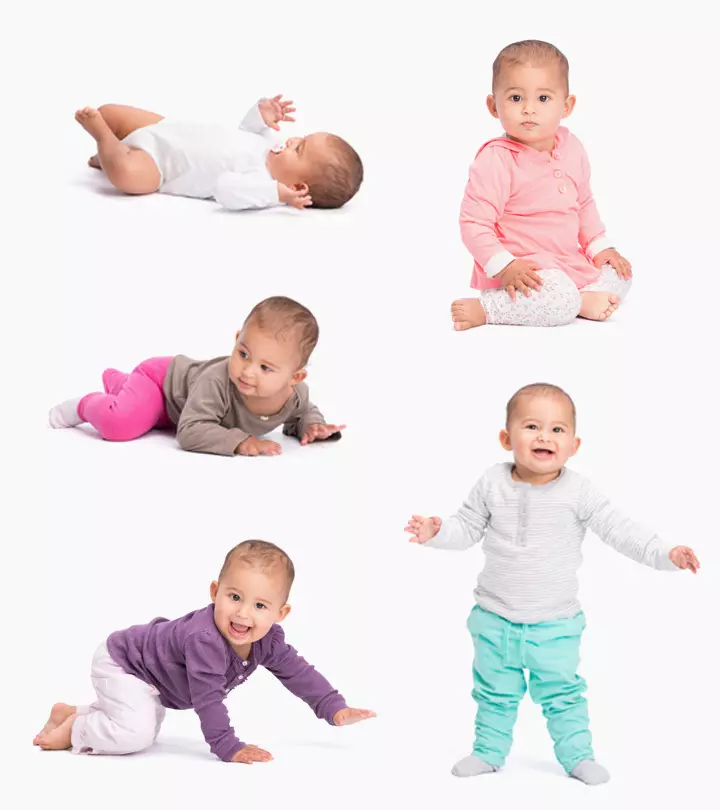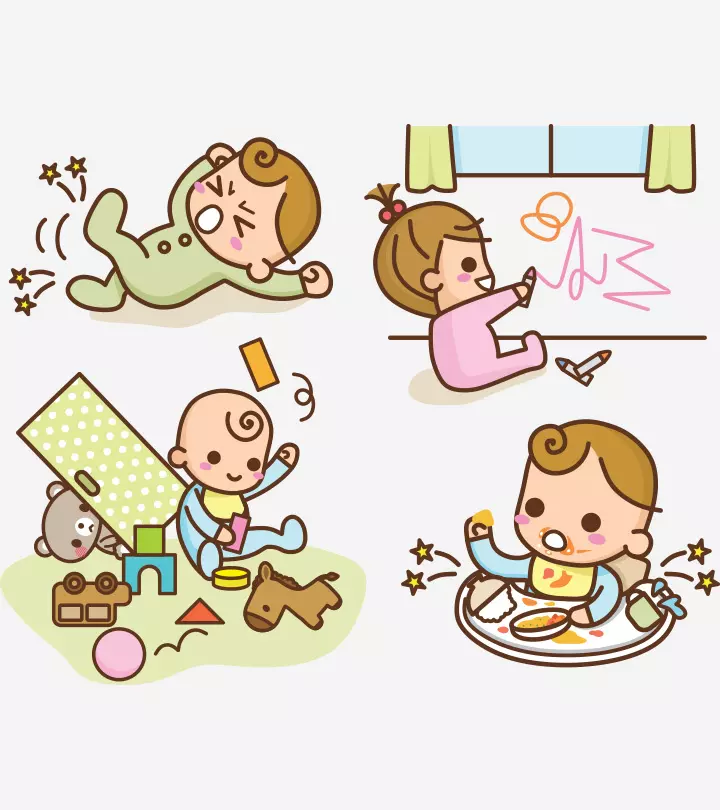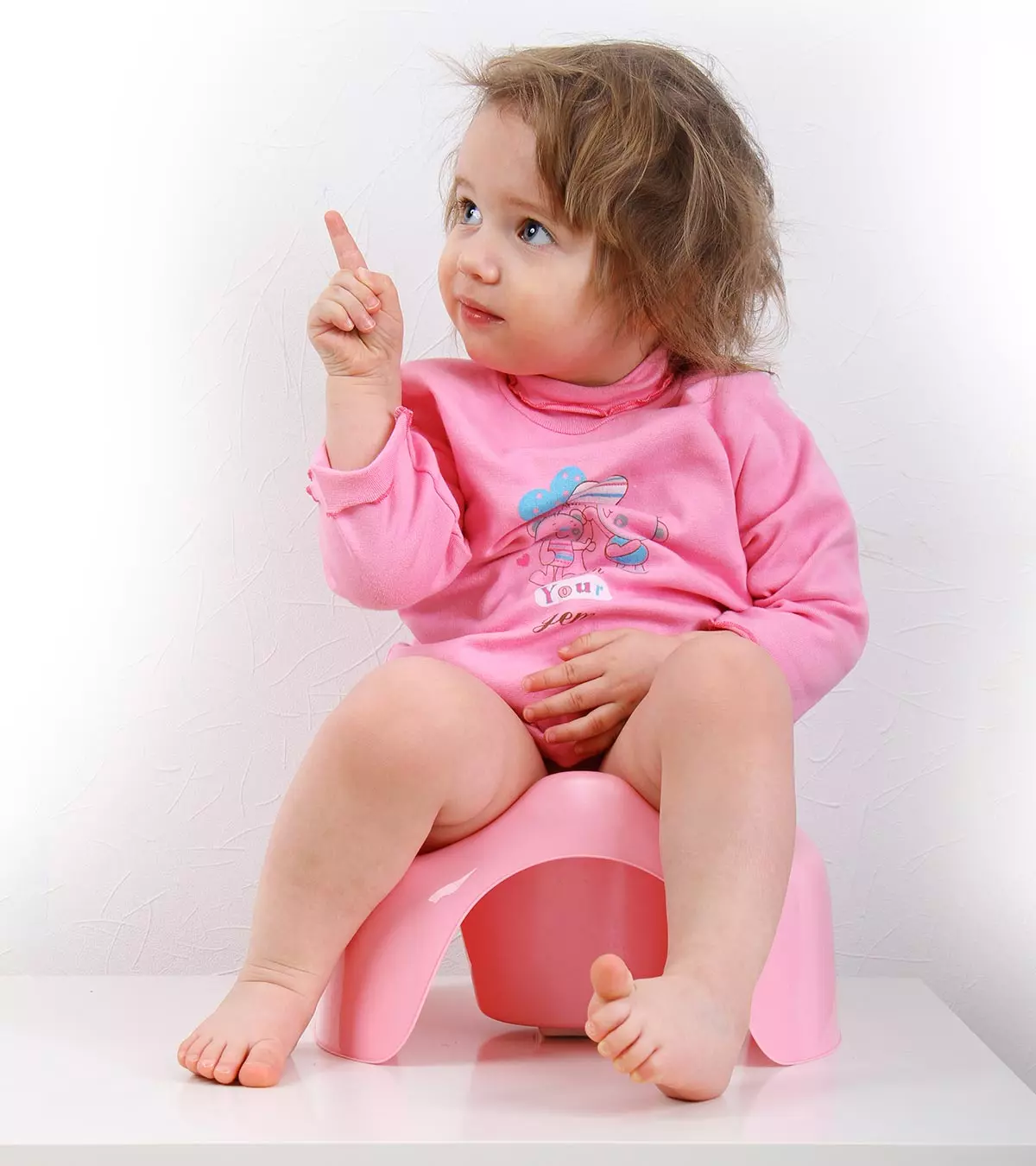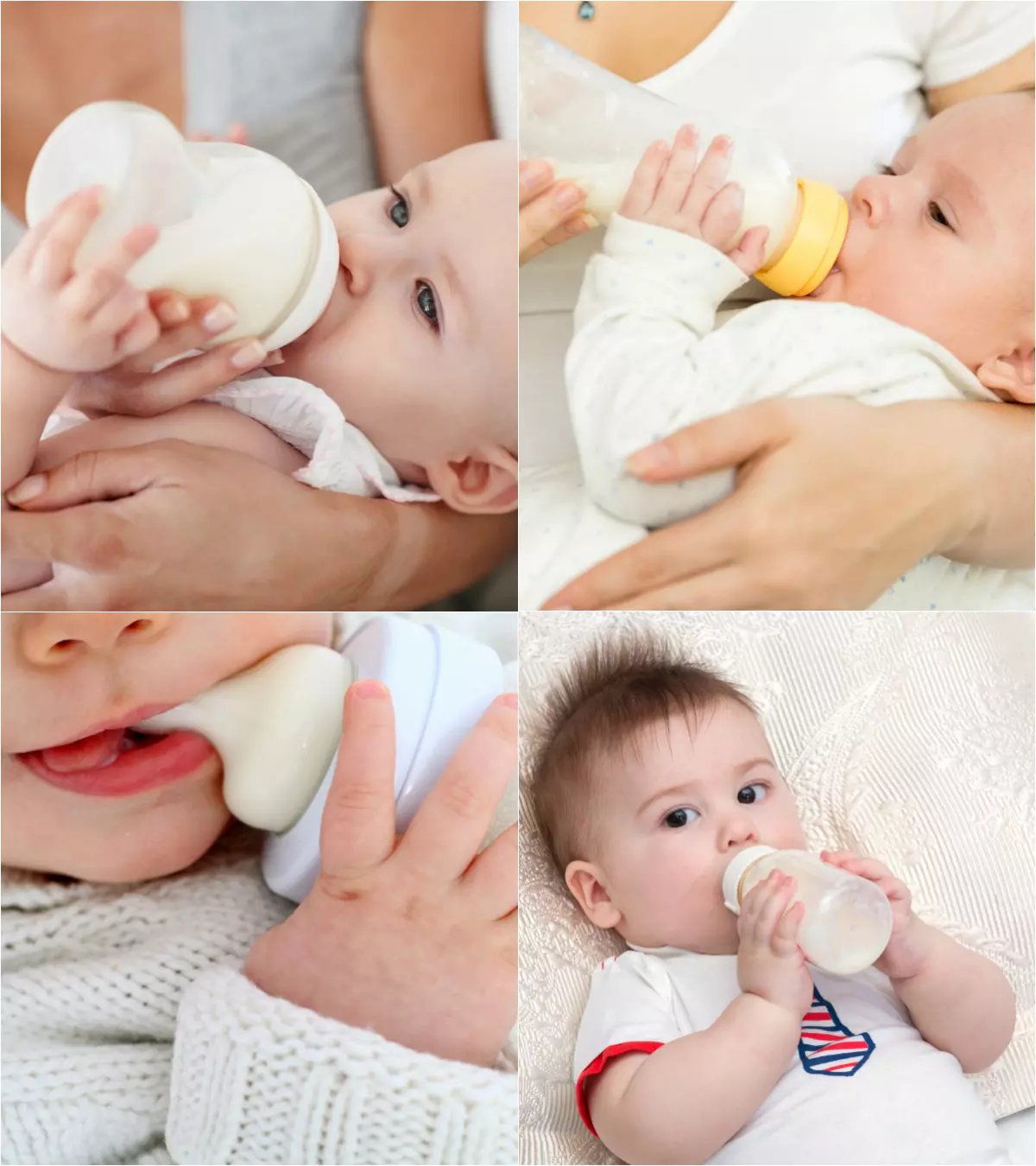
Image: ShutterStock
At around six months after childbirth, many mothers begin to experiment with their baby’s diet. As they gradually consider shifting to the bottle, a common question pediatricians are asked at this time is, “when can a baby hold a bottle?”
While it is safe to explore other nutrition options for your infant in this period, experts recommend nursing and breastfeeding a baby while feeding them other foods till one or two years of age, if possible.
Read on to know when do babies start holding their own bottle, tips to help them do so, and the precautions to take while they hold a bottle to prevent vomiting.
Key Pointers
- A baby can hold the bottle for around six months since they develop motor skills to hold objects.
- You may observe the baby’s motor skills, provide support, and give empty bottles and then filled ones.
- Touching the nipple of the bottle to the side of the lips can initiate a sucking reflex in babies.
When Can A Baby Hold The Bottle?
A baby should be able to hold a bottle from the age of six months because it is the time when they develop motor skillsiA set of abilities that help move and control various body parts, especially hands, legs, and fingers. to move objects from hand to hand.
This includes the grasping reflex in babies, and the baby can hold the bottle using all fingers. In fact, your baby’s ability to hold the bottle by the sixth month is one of the indicators of healthy development (1).
Babies develop the primitive palmar gripiA reflex or involuntary movement of the palm that helps infants grasp things. from the end of the fifth month. Therefore, it is quite likely that she may grab the bottle and hold it too.
However, it is not necessary that all the babies begin holding the bottle by the sixth month. Sometimes, she may not even show an inclination towards holding the bottle independently until 10 months or more.
This does not mean that she is lagging in development. As long as she meets other developmental milestonesiStages of a baby’s development in which they attain vital life skills as they grow. , this should not be a source of worry for you.
Also, do not be surprised if your baby begins to hold things as early as three months.
Make an effort to help her in accomplishing the task. But initially, it is best to bottle feed the baby by holding the bottle yourself. Keep the head of the baby up to prevent aspiration.
How To Make A Baby Hold The Bottle
The process needs to be gradual. Once you know when babies can hold their own bottles, You need to spend some time and not lose patience as your baby could learn the task after several attempts.
- Introduce your baby to the bottle during the feeding session, by making her touch and feel the bottle to get a sense of its shape, size, and weight.
- Initially, make her hold an empty bottle by putting her hands around it.

- Once she shows interest in gripping the bottle, fill the bottle in installments – quarter, half, and then full.
- When filling the bottle, you need to consider your baby’s ability to carry the weight of the bottle.
 Do remember
Do remember- Then slowly move the bottle in her hands near to her mouth. Touching the nipple to the side of the lips initiates the baby’s sucking reflex.
- If she holds the nipple to her mouth, due to the smell of the milk, and starts suckling, then it is an instant success! Otherwise, you can guide the nipple into her mouth.
- Support the bottle at the other end. Once you are convinced about her ability to have a decent grip on the bottle, let go of your hold, while keeping a watchful eye.
Holding a bottle marks a significant milestone in a baby’s development. Vadim Gut, a father, narrates how he made handles for his baby’s bottle so that it would be easier for his baby to grip it. He says, “As our baby grew older and reached the age where he could hold the bottle on his own, we realized the need for bottle handles. This would allow him to grip the bottle himself and give our hands a much-needed break…The final design worked flawlessly. My child could grip it securely without the handles breaking, and it assisted him in holding the bottle with ease (i).”
 Quick tip
Quick tip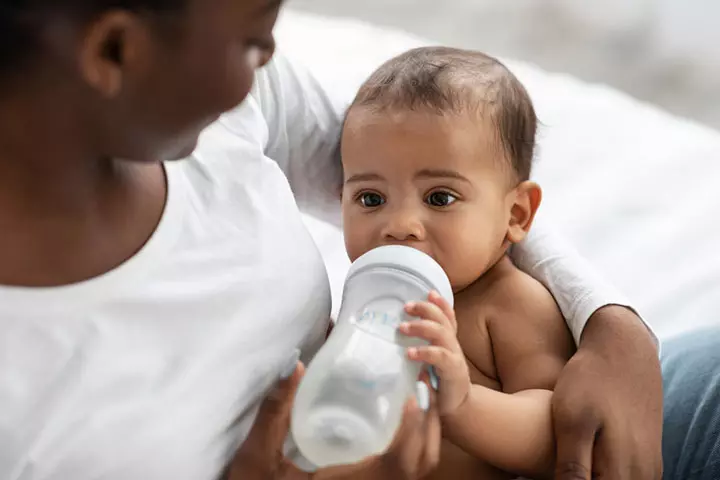
6 Tips To Help Your Baby Hold The Bottle
Your baby can show an interest in holding the bottle from an early age if you encourage her to do so.
Follow these tips to teach your baby the correct way of bottle-holding, and make her associate the bottle with her hunger.
1. Observe patterns in your baby’s motor skills
Do not force your baby to hold the bottle while feeding. Instead, go by her motor skill milestones. Babies usually learn to open and shut hands firmly by the age of three months. This means that there is a good chance for your baby to clutch her toys firmly, and move them.
Observe such playtime patterns and if she shows interest in holding objects, you may try to make her hold the bottle. Initially, make her hold small toys.
2. Teach the utility of the bottle
Make your baby understand the connection between her hunger and the feeding bottle . You can do this by giving her the bottle when she is hungry. Babies learn to recognize faces and objects at distance as early as three months, which means they can easily associate objects with a purpose. Training her little mind to look up to the bottle as a source of food will automatically stimulate her to take it when she is hungry.
3. Cuddle her

Your baby can feel the warmth of your body when you are breastfeeding her. Make her experience the same even when she is bottle-feeding. This will not make her feel deprived of your proximity. Holding the baby in your arms will make it easy for her to adapt to the bottle. Give her the warmth of the mother while bottle-feeding.
4. Maintain peace and silence during the feeding session
Do not distract the baby with noises when she is feeding. If there are too many things happening around her during the bottle-feeding session, she may not feed to her content or may be swallowing more air than milk. Distraction during feeding will result in the baby either losing interest in feeding or aspiration of milk. This can be dangerous.
Cuddle her in your arms while bottle-drinking. That way you can keep a watch on her while the warmth of your body keeps her calm.
 Point to consider
Point to consider5. Provide some support
Your baby’s tender arms could hurt while clutching the bottle for a long time. Therefore, put a cushion or a soft and safe object under their arms for supporting the bottle. You might also try holders that will keep the bottle in place. This will not only help your baby relax her arms but also keep the bottle in the right position when she is bottle-sucking. Keep the head of the baby in a raised position as compared to the body.
6. It is okay if she does not hold the bottle some days

On certain days, she may not want to hold the bottle. Just like adults, babies too can have mood swings. She may clench her fist and not open it. If that is the case then leave the matters there. Do not force her to feed from the bottle. She will reach out for it when she is hungry.
Most importantly, do not aim to teach your baby to hold the bottle in the first few days itself. Rushing through the process could make her develop an aversion or harm her physically. Take enough safety precautions to avoid any harm to your baby.
Precautions To Take When The Baby Holds The Bottle
Following these safety measures will make sure that there is no danger, however minor it is, for your baby.
1. Place the baby in the right position
The best position for bottle-nursing is the breastfeeding position: lying on the back cuddled in your arms. If you intend to put the baby on a surface, then keep her in a slightly arched position that mimics the natural breastfeeding position.
Never let the baby hold the bottle vertically straight or tip it over into her mouth (2). This could choke the baby or result in infection, if the contents flow out into her ears. The eustachian tubeiA passage connecting the middle ear to the pharynx/back of the throat. of babies is smaller and straight and the milk may go into the middle ear leading to ear infection. Instead, let the baby exert strength from her hand and decide the amount of tilt she requires for the bottle.
2. Do not leave the baby unattended
Even if your little bundle of joy has become independent with bottle feeding, you cannot leave her alone when she is drinking from it. Stay close and monitor your baby when she is feeding. If you feel she is losing her balance with her bottle, gently correct the position.
3. Listen carefully to feeding sounds
Listen to the sounds your baby makes when she is feeding. If she makes too much noise then perhaps she is sucking in a lot of air. Excessive gas can lead to coliciPeriodic and predictable crying episodes in infants for an extended period with no definitive cause. pain. Check the teat of the bottle for any blockage, and also the position of the bottle in her hand. Ensure that she has placed the nipple properly in her mouth.
4. Help remove the nipple from the mouth
Your baby could be a pro in holding the bottle but she may still need help in removing the nipple from her mouth, especially if she started holding the bottle at a younger age. Leaving the nipple for too long in the mouth can cause cavities in the baby’s mouth. Therefore, gently remove the nipple from her mouth after she feeds herself adequately. If she shows resistance or puts it back in the mouth then she is not full yet.
5. Never let the baby sleep with the bottle
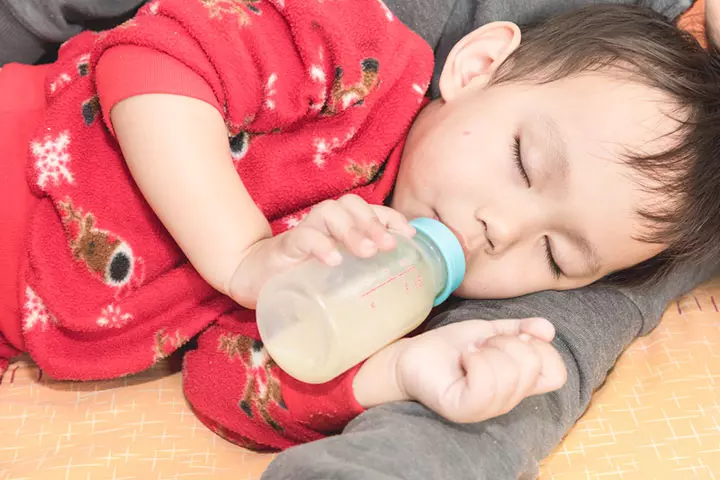
The bottle is not a toy and should never be left unattended with the baby. She may overfeed herself and it can be a choking hazard. Be watchful of your baby’s feeding habit by being around whenever she feeds. Babies tend to go to sleep while feeding. Do not let that happen.
When Should You Switch From A Bottle To A Sippy Cup?
The American Academy of Pediatrics advises introducing a cup to your child when they begin consuming solid foods, typically around six months (3). Incorporating a sippy cup with a small amount of water during meals is recommended. Although your baby may not consume much water initially, providing a sippy cup allows them to develop hand-to-mouth coordination and fosters a sense of independence during meals (4). Initially, demonstrate how to lift the cup and sip water slowly to prevent spillage due to its weight. Generally, between six and twelve months, most babies are ready to drink from a cup (5), but it’s essential to be responsive to your baby’s unique pace and introduce the cup when prepared.
Frequently Asked Questions
1. How do I choose the right bottle for my baby?
To choose the right feeding bottle for your baby, pay attention to its shape and material. You may buy a bisphenol A (BPA)iA chemical predominantly used in the production of plastics . -free plastic bottle or a glass bottle with a silicone cover. Stainless steel and silicone bottles are also good options. Remember that different bottles suit different babies, so you may have to try a few varieties to decide which bottle suits your little one the best. As your baby gets used to bottle feeding, you may buy bottles of other shapes too (6).
2. What bottles are not recommended for babies?
Clear plastic bottles with recycling number ‘7’ or the letters ‘PC’ written on them are not recommended for babies. These may contain BPA (7).
3. Can holding their own bottle lead to overfeeding or underfeeding?
If a baby can hold their bottle without any restrictions, they could drink more milk than necessary and overeat. On the other hand, if they struggle to hold the bottle or have difficulty drinking from it, they might not consume enough milk and be underfed.
Six months is roughly when a baby can hold a bottle as it is the time when most infants learn to grasp objects. Initially, let her hold an empty bottle, guide the nipple to her mouth, support the bottle with your hand, and progress each day gradually. Offer warm cuddles and a soothing environment while feeding to help her adapt to independent bottle-feeding. Ensure the baby is not unattended during feeds and has not fallen asleep with the bottle. Being able to hold a bottle is one of the many vital milestones in the baby’s first year. However, remember that babies may reach milestones at different times, so do not panic if your baby develops this ability later than others.
Infographic: How Can You Help Your Baby Hold A Bottle?
Some babies may begin holding their bottle when they begin feeding solids, which could be around six to eight months; however, not all babies may learn the skill at the same time. If you wish to help your baby hold a bottle, this infographic can guide you with some valuable tips. Illustration: Momjunction Design Team
Illustration: MomJunction Design Team
Illustration: When Can A Baby Hold Bottle: 6 Easy Tips To Help With It
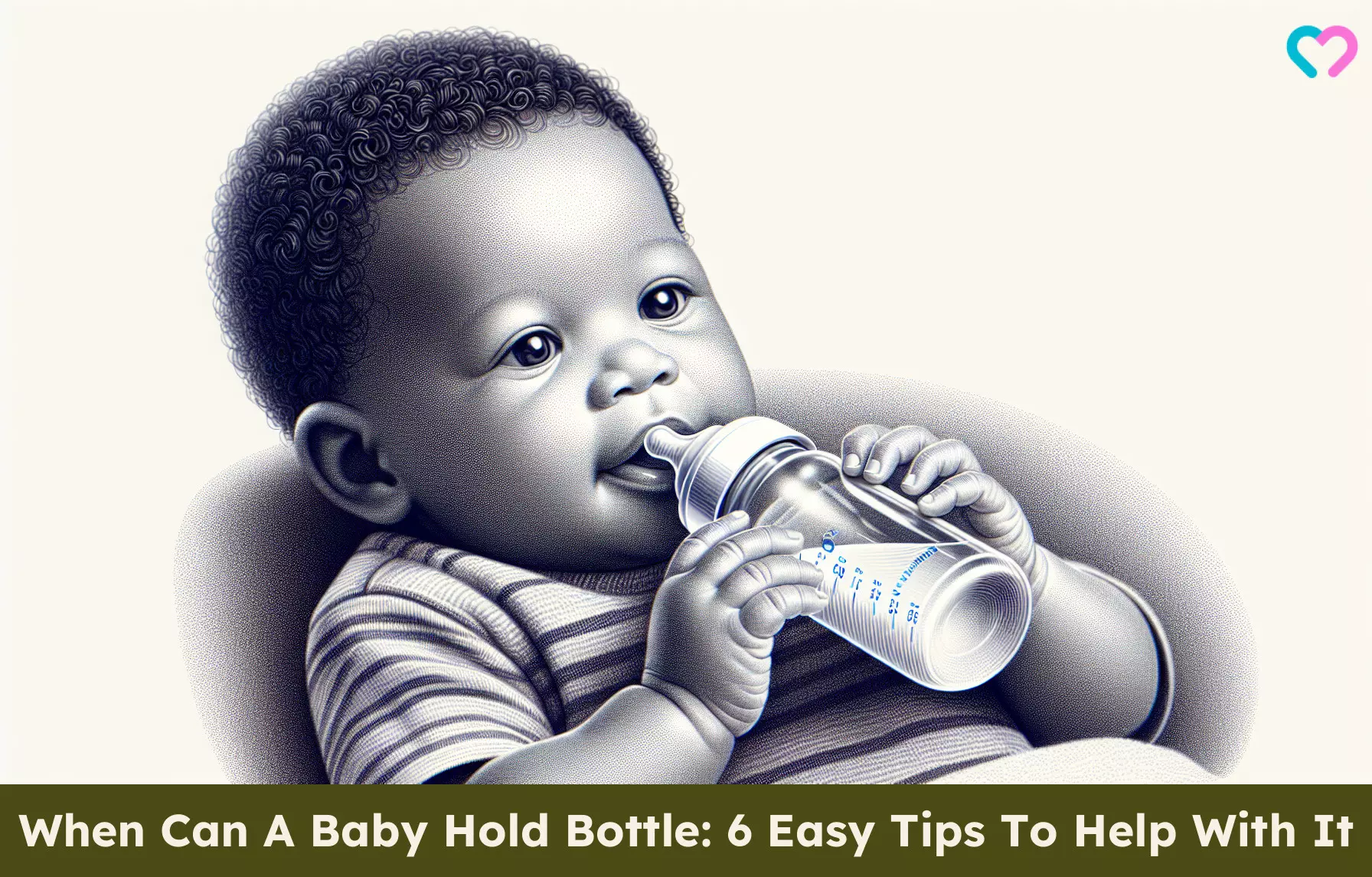
Image: Dall·E/MomJunction Design Team
Personal Experience: Source
MomJunction articles include first-hand experiences to provide you with better insights through real-life narratives. Here are the sources of personal accounts referenced in this article.
i. Because If The Company Not Gonna Do It I Will, Lansinoh Baby Bottle Handles.https://medium.com/@vadim.g/because-if-the-company-not-gonna-do-it-i-will-lansinoh-baby-bottle-handles-43f6c511dbe5
References
- First Year Infant Development.
https://americanpregnancy.org/healthy-pregnancy/first-year-of-life/first-year-infant-development/ - Bottle-Feeding.
https://www.urmc.rochester.edu/encyclopedia/content?contenttypeid=90&contentid=P02639 - From Bottle to Cup: Helping Your Child Make a Healthy Transition
https://www.healthychildren.org/English/ages-stages/baby/feeding-nutrition/Pages/Discontinuing-the-Bottle.aspx - Introducing a Sippy Cup to Your Baby.
https://www.lancastergeneralhealth.org/health-hub-home/motherhood/the-first-year/introducing-a-sippy-cup-to-your-baby - Transitioning from a bottle to a cup
https://slhd.health.nsw.gov.au/community-health/services - Formula Feeding FAQs: Getting Started.
https://kidshealth.org/en/parents/formulafeed-starting.html - Baby Bottles and Bisphenol A (BPA).
https://www.healthychildren.org/English/ages-stages/baby/feeding-nutrition/Pages/Baby-Bottles-And-Bisphenol-A-BPA.aspx - Eye contact helps babies learn to talk
https://www.allinahealth.org/healthysetgo/care/eye-contact-helps-babies-learn-to-talk#:~:text=Whether%20breast%2D%20or%20bottle%2Dfed,a%20moment%20between%20two%20people
Community Experiences
Join the conversation and become a part of our nurturing community! Share your stories, experiences, and insights to connect with fellow parents.
Read full bio of Dr. Mubina Agboatwalla
Read full bio of Rohit Garoo
Read full bio of Dr. Ritika Shah
Read full bio of Ghazia Shah






